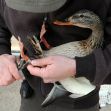Five days before leaving office, ex-President Trump’s Fish and Wildlife Service (FWS) published a rule that could assure that he will not be the only one who loses his current home. The rule, which strips nearly 3.5 million acres of forest from federal protection, may soon cause the Northern Spotted Owl to become homeless as well, and, as a result, face extinction.
The medium-sized, dark-brown owl has already lost more than 70 percent of its population since it was designated as “threatened” in 1990. Its current forest home is classified as a “critical habitat,” a term the Endangered Species Act uses for areas deemed essential for a species to recover.
The Northern Spotted Owl is not only threatened by loggers, but it also faces serious risks from wildfires and competition from other owls that have migrated from the east. In addition, the owl’s current moss-covered forest home of hundred-year-old trees contains “old growth that help(s) the trees soak up climate-warming carbon,” according to Trina Bayard, director of bird conservation for Audubon Washington.
The owl, which lives in the Northwest, has been at the center of environmentalist versus logger controversies since the 1990s. In 1990, it was allotted 6.9 million acres of critical habitat in Washington, Oregon and California. That amount was revised downward to 5.3 million acres in 2008.
Since then, several timber companies have continuously challenged the amount of protected land as well as other pro-conservation, governmental restrictions on timber harvesting. In 2012, a rule was passed that set aside 9.5 million acres of forest by designating it a “critical habitat” for the threatened species.
Lawsuits and appeals followed until last April when FWS reached a settlement with the American Forest Resource Council, a trade association for the logging industry. The agreement required the agency to re-evaluate its designated habitat. The trade group argued that the nearly ten million-acre forest should not be designated as a “critical habitat” because it includes areas where the owl does not live and because the 2012 ruling failed to consider the economic impact of the Endangered Species Act’s (ESA) designation.
The ESA allows the exclusion of areas from “critical habitat” status if failure to do so, according to the best available scientific evidence, would result in the extinction of the species. The settlement led to an FWS proposal in the Federal Register last August that sought to remove 200,000 critical habitat acres in Oregon. Environmentalists commented the owl’s population is endangered by any reduction in protected areas, which are already endangered by wildfires and climate change.
Timber companies were not pleased with the small size of the 200,000-acre designation. Their comments sought the removal of 2.7 million acres in order to prevent “calamitous economic losses,” according to the New York Times.
In a move that surprised environmentalists and endangered species experts, the FWS’s January 15 ruling, which will take effect on March 16, stated, “This rule revises the 2012 critical habitat designation based upon the Secretary's determination that the benefits of exclusion of particular areas of critical habitat outweigh the benefits of designation of particular areas of critical habitat based on economic, national security and other relevant impacts. Based upon the best scientific and commercial data available, the Secretary has not concluded that these exclusions will result in extinction of the species.”
This ruling will remove more than half a million acres of protected lands in the Cascades in Washington and three national forests near Seattle— the Mount Baker-Snoqualmie forest, the Okanogan-Wenatchee forest, and the Gifford Pinchot forest. That is 15 times the amount it had previously proposed opening to the timber industry.
This ruling added another .8 million acres to the FWS August proposal, bringing the total reduction to 3,472,064 acres. Susan Jane Brown, a staff attorney for the Western Environmental Law Center, told Audubon News that biologists in the government told her the reduction in protected habitat was an “extinction action” for the bird.
Kristen Boyles, a staff attorney for Earthjustice, was shocked by the ruling as well. She asked the New York Times, “How in the world have they gone from a couple hundred thousand acres to 3 million acres and it wasn’t announced?” Boyles added, “That will be a primary focus of any legal challenge, and it will be challenged. There is no question.”
FWS Director Aurelia Skipwith would not address extinction threats, telling Audubon, “The Trump Administration and the Service are committed to recovering all imperiled species, and the northern spotted owl is no exception. These commonsense revisions ensure we are continuing to recover the northern spotted owl while being a good neighbor to rural communities within the critical habitat.”
The Northern Spotted Owl decision is what the New York Times said was “the latest in a series of midnight regulations by the Trump administration…that privilege industry over protecting the environment.” Government agencies have also eliminated fines, prosecution for killing migratory birds, and reducing protections for other animals and plants that had been protected by the ESA.
The newspaper also attributed the spotted owl rule to former Interior Secretary David Bernhard who was a lobbyist for oil, gas and mining companies before joining the Trump administration.
Environmental groups are certain to file suit to challenge the rule. To be successful, they will have to use the Congressional Review Act, which allows the nullification of recently finalized federal regulations that get a simple majority vote in the House and Senate. But there isn’t much time before the March date that will allow the act to take effect.
Still, Americans should take heart that the new administration, unlike its predecessor, might do the right thing. It just might give a hoot about the fate of the Northern Spotted Owl.






